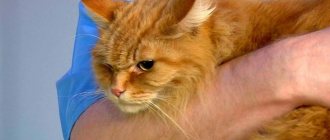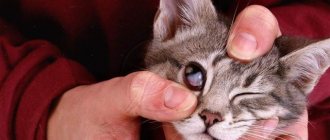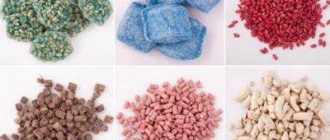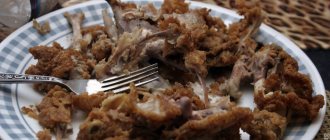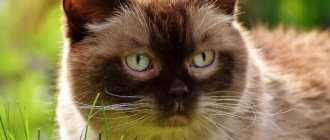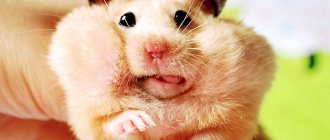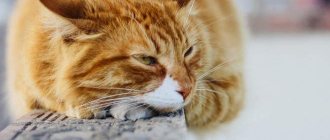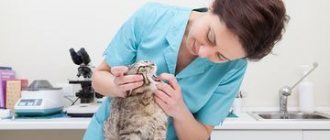Symptoms of heart problems
How can you even understand that your pet has some kind of heart problem?
The problem is that cats are notorious couch potatoes. And if “problems” in the behavior of the same dogs quickly become obvious during regular walks, a cat’s illness can remain completely unnoticed for a long time. However, you may notice that your pet has become more “lazy” and tries not to move unless absolutely necessary. If the cat “deigns” to walk to the bowl, it is not difficult to notice that such a simple action was not easy for him: the animal begins to choke, wheeze and cough.
It is no coincidence that veterinarians consider early diagnosis of heart pathologies in cats to be a difficult and thankless task. Often there are no clinical signs at all. Until the pet’s body passes some “critical point”, after which the symptoms begin to increase exponentially.
As for the characteristic signs of cardiac pathologies, these include:
- difficulty breathing; wheezing;
- severe shortness of breath that occurs even after light physical exertion;
- in severe cases (even without a phonendoscope), you can hear something gurgling and bubbling noisily in your pet’s chest. These are very alarming signs indicating the presence of profuse effusion in the chest cavity. The fluid compresses the lungs and heart, causing all the breathing problems described above to develop;
- severe hypothermia of the limbs and other parts of the body (for example, ears and paws);
- paleness of all visible mucous membranes (gums and eyes). All this indicates a serious deterioration in blood circulation in the animal’s body;
- in severe cases (often when the cat is already dying), the skin over the entire surface of the body becomes cold.
Note that coughing with heart disease is not typical for cats. This sign is more often observed in sick dogs. It is highly likely that in cases where your cat is coughing uncontrollably and panting heavily, the heart has nothing to do with it. Most likely, we are talking about bronchitis or other lung diseases.
Treatment of a pet who has had a heart attack and prevention of the disease
Treatment of a heart attack in a cat should begin only after an accurate diagnosis. In a veterinary clinic, the animal undergoes diagnostic measures to determine the degree of damage and the condition of the entire body against the background of ischemia.
First of all, a veterinary specialist conducts auscultation (listening), identifying disturbances in the heart rhythm and the possibility of the appearance of heart murmurs. Electrocardiography is necessary to identify true ischemic changes in the myocardium.
Ultrasound is widely used to diagnose myocardial infarction in veterinary medicine. Carrying out instrumental analysis using an ultrasound machine makes it possible not only to assess the condition of the heart, but also to diagnose stenosis in large arteries, as well as hypertrophy in the left ventricle.
For diagnostic purposes, a complete blood count and biochemistry are performed to detect leukocytosis, increased erythrocyte sedimentation rate, and changes in the levels of alkaline phosphatase, amylase, creatinine, and cardiac enzymes. Rarely, X-ray examinations of the chest area are prescribed. It is necessary to exclude hypertrophic cardiomyopathy, arrhythmia, or myocardial defects.
Drug treatment for a heart attack in a cat is prescribed only by a specialist. Self-medication is unacceptable, as it can negatively affect the general condition of the animal. First of all, medications are prescribed to relieve pain. Painkillers such as Ketofen and Ketonal are widely used in veterinary medicine.
If a heart attack is diagnosed, the following are also prescribed:
- antithrombic drugs - Heparin and Warfarin (aspirin is contraindicated for cats);
- sedatives (sedatives) – Kot Bayutn, Fospasim, Fitex;
- diuretics - to relieve swelling and reduce the load on the myocardium (Furosemide, Veroshpiron);
- beta-blockers - increase myocardial function, supply oxygen and increase metabolic processes (Atenol, Metoproloo, Propranolol);
- vitamin complexes (vitamin C, B5, B6, B12).
The further rehabilitation period depends on the correct organization of keeping the animal in the post-infarction state. It is necessary to provide the cat with peace by placing it in a quiet room where the least number of people walk and no one will disturb the pet.
It is important to prevent possible unrest and stressful situations in order not to aggravate the animal’s condition.
It is also necessary to take care of physical activity - it needs to be minimized. The diet should consist of light foods without fat. You can give fermented milk products, lean beef and low-fat varieties of boiled sea fish. Cats fed ready-made food must be switched to a special diet.
It is necessary to select a special ready-made granular or wet food of super-premium class, suitable for pets with heart problems.
It is practically impossible to prevent myocardial infarction in cats. The owner can only minimize risks by adhering to certain rules. A special place is occupied by the organization of the animal’s diet, because obesity is one of the main causes of disorders in the cardiovascular system.
For preventive purposes, it is necessary to enrich the cat’s diet with the essential amino acid taurine, which has a beneficial effect on the animal’s cardiovascular system.
It is important to promptly treat chronic diseases in your pet and undergo preventive examinations by a veterinarian once every six months to a year.
veterinarian - the answer will be sent to your email
Rules of care and feeding
The success of therapeutic measures for myocardial infarction in a domestic cat largely depends on the competent behavior of the owner. First of all, the sick pet is given complete rest. The cat should be placed in a calm and quiet corner of the apartment, protected from the presence of children and strangers. It is good if the room is equipped with a secret darkened place where the animal will feel safe.
A cat that has suffered a myocardial infarction should be protected from psycho-emotional unrest and stress. The atmosphere in the house should be calm and friendly.
The owner should ensure that physical activity is minimal. Quiet short walks in the fresh air in familiar surroundings are recommended. A sick pet needs to review the menu. Food should be light, not greasy.
Preference should be given to fermented milk products, lean beef, and fish. Pureed buckwheat, oatmeal, and rice porridges cooked in water or chicken broth are useful.
Fatty meat and fish, as well as food from the table: sweets, smoked and canned foods, are completely excluded from the diet of a sick cat. On the recommendation of a veterinarian, the animal can be switched to easily digestible super-premium food.
Myocardial infarction in furry pets is a rare but dangerous phenomenon. The insidiousness of the disease lies in the absence of characteristic symptoms and the need for hardware diagnostic methods. Timely and competently prescribed treatment allows the animal to adapt to the new condition. The success of therapy largely depends on proper care and diet.
Useful video
Diagnosis of myocardial infarction
A veterinary doctor can start thinking about myocardial infarction as soon as he sees the animal, since the symptoms are quite vivid and characteristic.
Thanks to instrumental diagnostic methods (echocardiography, electrocardiography), the veterinarian will carry out a differential diagnosis of a heart attack with other heart diseases that can cause similar symptoms, and will also check for brain diseases.
These are pathologies such as inflammatory diseases of the membranes of the walls of the heart (endocarditis, myocarditis, pericarditis, pancarditis), myocardosis, and various types of cardiomyopathy.
The distinctive features of a heart attack from any other heart disease on the ECG are:
- Pathological ST segment elevation.
- The growth of the Q wave is the main wave indicating the process of ischemia.
- Signs of bundle branch block appear.
An ultrasound can show interruptions in the functioning of the affected chamber of the heart (right and left ventricle).
Fluffy diagnostics
Due to the fact that the symptoms of the disease are not pronounced, the veterinarian uses instrumental research methods for diagnosis. Using a phonendoscope, he will listen to the heart rhythm and detect arrhythmia, tachycardia, and heart murmurs.
The animal is also subjected to tonometry to determine blood pressure.
Carrying out electrocardiography and its qualified interpretation makes it possible to identify ischemic conditions in the myocardium. Pathology reveals disturbances in the ST segment and changes in the direction of T-waves, high and sharp T-waves (in the first few hours). The study allows you to identify Q-waves and detect bundle block.
An informative method for diagnosing a heart attack in cats is cardiac ultrasound. The method allows you to assess the condition of the myocardium, detect stenosis of large vessels, and determine the degree of left ventricular hypertrophy. Echocardiography can detect blood clots, congenital anomalies and malformations of the heart muscle.
Clinical and biochemical blood tests in acute ischemia will show slight leukocytosis, an increase in ESR, an increase in the level of ALT, AST, and alkaline phosphatase enzymes. Elevated amylase, creatinine, and cardiac enzymes may also be detected.
In some cases, your veterinarian will order a chest x-ray. For the purpose of differential diagnosis, monitoring using the Holter method can be used. A veterinary cardiologist will rule out cardiac pathologies such as various arrhythmias, heart defects, and hypertrophic cardiomyopathy.
To learn how an ECG is taken in cats, watch this video:
Prevention available to everyone
It is very difficult to prevent the occurrence of cardiac necrosis in a pet. In addition, veterinarians are rarely able to identify it in time. However, the owner is able to take preventive measures that will help his mustachioed friend remain healthy and active for a long time.
The main component of a strong immune system is good nutrition. An excess of fatty meat will lead to the formation of cholesterol plaques inside the blood vessels. If the drinking regime is disturbed, there is a high risk of blood clots. This occurs due to poor blood clotting.
Taking human medications by a pet without the supervision of a specialist causes blockage of blood vessels and irreversible changes in the body that cannot be corrected. In case of illness, it is necessary to strictly follow the doctor's instructions. He can determine the lack of nutrients in the body by appearance or give recommendations after conducting a comprehensive study.
Recently, there has been a clear opinion among veterinarians and scientists that the main cause of heart disease is a deficiency of an amino acid called taurine. Adding this beneficial component to food leads to a significant reduction in the risk of heart disease in pets.
Creating comfortable living conditions also has a good effect on the pet’s life expectancy. If he lives in a loving family, where he is caressed and cared for, then the cat will receive a minimum of heart-damaging stress. You need to take care of your pet's physical activity. They should be age appropriate and not excessive. You should play with him more often, allow him to walk in the fresh air and protect him from hypothermia.
The article is for informational purposes only. Contact your veterinarian!
Prevention of heart attack in cats
Preventing heart attacks in cats is difficult because it is extremely difficult to avoid. Although this disease is rarely recorded in animals, it still develops. All the owner can do is balance the pet’s diet (nothing fatty). Nutrition should not change metabolism, and plaques should not form in blood vessels. And the blood should not clot too much (otherwise there is a high risk of blood clot formation). So give more water.
In most cases, timely and correct treatment of a cat for a heart attack saves the animal from the sad fate of a disabled person or death. Drug therapy includes procedures such as:
- taking sedatives;
- taking blood thinners;
- taking diuretics;
- cardiac stimulation, etc. at the discretion of the veterinarian.
The animal needs to create the necessary conditions for recovery and ensure peace. Even with a heart attack, cats and cats are prescribed diet therapy. As a rule, these are light, low-fat foods. Still not allowed beef, lamb, liver, cheese.
Remember, the best treatment is prevention. It is better to prevent the development of the disease than to cry later that the mustache is suffering.
By the way, I think you will be interested to know that scientists have not only determined whether cats have a heart attack or stroke, but also found out the cause that causes heart failure. As it turned out, most often the disease develops due to a deficiency of the essential amino acid taurine.
Recently, the efforts of veterinarians and nutritionists in this direction have begun to bear fruit. Nowadays, taurine is added to cat food by default, even without always indicating it on the packaging, which has led to a significant reduction in the incidence of heart disease in our beloved pets.
Video about heart disease in cats:
source
Treatment prescribed by a veterinarian
The veterinarian begins urgent measures to prevent an attack and its consequences immediately after an accurate diagnosis. Drug therapy for heart attacks in cats is prescribed only by a specialist. Self-medication is unacceptable, because it can have a bad effect on the general condition of your mustachioed friend.
First of all, medications are prescribed to relieve pain. Painkillers such as Ketofen and Ketonal are popular in veterinary medicine.
In case of diagnosed illness, the following are used:
- drugs against blood clot formation - Heparin and Warfarin;
- sedatives, sedatives - Kot Bayutn, Fospasim, Fitex;
- diuretics that help remove swelling and reduce the load on organs - Furosemide, Veroshpiron;
- adrenaline beta blockers, which increase myocardial function - they supply oxygen and help increase metabolic processes - Atenolol, Metoprolol, Propranolol;
- complexes of vitamins C, B5, B6, B12.
At any stage of a heart attack in cats, a drip with a water-salt solution is used to help protect the body from dangerous dehydration. For this purpose, injections are given from saline or glucose solution, doing them in turn.
Severe pain syndrome rarely goes away on its own, and without adequate medical care the patient almost always dies. If the use of analgesics was timely, the discomfort in the sternum will disappear in a couple of minutes.
Treatment of the disease
Only a veterinarian or cardiologist should prescribe drug treatment for myocardial infarction. It is strictly forbidden to self-medicate such a life-threatening illness for your pet.
First of all, when a diagnosis is made, the cat is prescribed painkillers to relieve pain. For this purpose, analgesics such as Ketofen, Ketonal, etc. are used.
To prevent thromboembolic complications, Heparin and Warfarin are administered to a sick pet. Aspirin is contraindicated as an antithrombotic agent in the domestic cat.
The furry patient is required to be prescribed sedatives: drops “Cat-Bayun”, Stop-stress, Fospasim, Fitex.
According to indications, the veterinarian may prescribe diuretics, for example, Furosemide, Veroshpiron, Torasemide.
Beta-blockers help improve the functioning of the heart, supply it with oxygen, and increase trophism: Atenolol, Propranolol, Metoprolol retard. A course of Solcoseryl will speed up the process of tissue regeneration in the heart. Vitamin therapy is useful for a sick pet. For this purpose, B vitamins and ascorbic acid are used.
Heart attack in cats
Heart attacks also happen in cats. It sounds terrible, but no one is immune from illness. And it is impossible to predict when and what your pet will get sick with. This is easier for people: they had a heart problem, they went to the doctor and managed to prevent trouble. But with animals everything is much more complicated. They won’t tell you where, how long ago and how much it hurts. And often owners notice symptoms of heart disease in a cat too late.
Myocardial infarction in cats, although a rare occurrence, does occur. And there are as many dangers for the health and life of a pet as there are for humans. And all because myocardial infarction is the death of a section of the heart muscle. Because of this, the heart stops functioning normally. And the whole body seems to “fall apart.” Without proper treatment, the mustache will die.
Causes and types of disease
The factors that provoke myocardial infarction in cats are very diverse. Disturbances in the functioning of cardiac muscle tissue can be caused by congenital or acquired causes. In this regard, they talk about four types of pathology:
- Transmural subtype
characterized by widespread damage to the myocardial muscle.
- Intramural type
affects the thickness of the walls of the ventricle located on the left side, without affecting the endocardium.
- Subendocardial type
aimed at a narrow line in the area of the left ventricle.
- Subepicardial view
characterized by lesions near the epicardium.
Depending on the size of the affected area, the lesions are large-focal and small-focal.
The ancestors of the domestic pet, like their closest relatives, always tried to hunt from ambush. It was unusual for them to pursue prey for a long time. Because if a representative of the cat family experiences prolonged physical activity, he develops tachycardia. The same applies to a domestic cat, therefore, if he plays too much, the volume of blood in the circulatory system becomes less. This further leads to a decrease in pressure, and in advanced cases, to cell death.
Poor myocardial function occurs in juveniles and adults. The former suffer from pathologies in the cardiovascular system due to congenital problems during the intrauterine development of atrioventricular organs and disorders in the blood vessels. Aging cats are susceptible to defects acquired with age that provoke necrosis of the myocardium.
There are a number of additional factors that cause heart attacks in cats:
- Inflammation occurring in blood vessels. Vasculitis occurs systematically and appears due to processes of an autoimmune nature. Changes in the vascular walls lead to severe changes in metabolism and push towards the development of an acute form of the disease.
- Thromboembolism is blockage of the lumen in a vessel by foreign bodies: cells of a malignant or benign tumor, parasites, blood clots, air bubbles due to poorly performed surgery or when drugs are administered intravenously.
- Problems with the endocrine system. The cause of a heart attack in cats can be diabetes mellitus, as well as abnormally high secretion of hormones by the thyroid gland.
- Chronic diseases of the lungs and heart.
- Infection with pathogenic fungi or harmful microorganisms. For example, necrosis can be provoked by purulent inflammations - pyometra, pyelonephritis, glomerulonephritis.
- Bleeding due to surgery or injury that leads to irreversible damage to the cardiovascular system.
- Increased pressure inside the arteries leads to overload in the myocardium, provoking the onset of a destructive process.
- Poisoning with toxic substances: salts of heavy metals, phosphorus-containing substances, poisons. This affects the functioning of all internal organs.
The reasons that cause the development of a heart attack in a cat can indirectly include the animal’s light physical activity and a sluggish lifestyle. Excess weight also has a bad effect on the oxygen supply to muscles.
Emotional stress and stress have a negative impact on your pet’s health.
With an incorrect diet, a deficiency of an important amino acid occurs. A poor supply of taurine leads to the formation of cholesterol plaques.
However, cats rarely suffer from such severe disorders, which lead to thickening of the vascular walls. Often, even elderly individuals retain the heart muscle in good condition. In most reported cases, such a pathology is an irreversible congenital defect.
Preventive actions
To prevent myocardial infarction in cats, it is important for owners to provide the animal with moderate physical activity in the fresh air. If you send your pet outside or you can’t go for a walk with him, you can set up a house for your cat with toys on the balcony
Playing with cat objects increases the load on the heart, making the heart muscle stronger and less susceptible to an attack.
An important preventative measure is the hygiene of the animal and keeping its tray clean. A cat's litter box contains a variety of parasites, so it is important to clean it after each pet's bowel movement.
In addition, the owner needs to diversify the animal’s diet and include foods containing sufficient amounts of vitamins and minerals.
Veterinarians advise giving cats boiled potatoes, legumes, fish and dairy products. The animal can also obtain useful substances from vitamin-mineral complexes, which are given in the spring and autumn. You can buy them in pharmacy chains. Owners should also regularly visit a veterinarian with their cat, which will allow them to identify any pathologies of the cardiovascular system at the initial stages of development, carry out their timely treatment and prevent the development of serious complications that can even lead to death.
This is also interesting!
Among the heart diseases among the most beloved pets is heart attack. Yes, no matter how terrible it may sound, pussies also suffer from heart pathologies. And while a person, feeling pain, rushes to the hospital, where entire teams of cardiologists, therapists and the most modern equipment are at his service, his tailed friend stoically endures all health problems, without being able to complain. That's why owners who are not too attentive sometimes realize it too late, when their beloved animal is already in the complete grip of a terrible disease.
Fortunately, myocardial infarction is rare in pussies. And, nevertheless, it happens, which means it carries a mortal danger. After all, the disease leads to atrophy of the heart muscle, and without the heart life is impossible, everyone knows this. An animal sometimes dies before a person has time to understand what happened to it.
Age. Time is the most terrible enemy of all living things. As an animal ages, it undergoes hormonal changes. It is becoming increasingly difficult for organs, including the heart, to perform their functions. And physical stress contributes to even greater wear and tear on the pet’s main driving force, its heart. Therefore, there must be moderation in everything. Even if your pet is ready to actively play with you, you should not drive him too much. The physical condition of the animal no longer allows it to cope with such a load.
Diet. An incorrectly designed menu throughout the pet’s life leads to the formation of a cholesterol layer on the blood vessels. This complicates their blood supply and causes a deficiency of oxygen, which, as is known, is a symbol of life. Without it, cells die, and this is a direct path to myocardial infarction in the pussy.
Thrombus. Blood clots that form in the vessels can break off and block the flow of blood. This also leads to cellular oxygen starvation and the development of a cat’s heart attack.
Other reasons. Diseases of the vascular system, inflammation, including those of infectious origin, genetic abnormalities, and other factors can provoke myocardial infarction in a pet.
A heart attack can be primary, spontaneous and repeated, cyclical and recurrent, protracted. Possible coronary death.
- pre-infarction;
- the most acute stage (from a quarter of an hour to 2 hours);
- acute infarction with the formation of a necrotic focus (from 2 hours to 2 weeks);
- subacute period - granulation and the beginning of scarring of the necrotic lesion (from 1 to 2 months);
- post-infarction
Sometimes cats experience several types of heart attack simultaneously or sequentially. Major heart attacks are rare in cats, but they are not excluded. This is a very serious condition for the animal and can cause death. There can be no talk of any self-medication.
Coronary heart disease in cats symptoms
Disruption of the cardiovascular system is possible not only in humans, but also in animals. A heart attack in cats is no different in pathogenesis from humans: in one of the areas of the heart muscle the blood supply is cut off, and then the affected muscle becomes necrotic, which leads to organ dysfunction. Development and death are possible without timely medical care.
To prevent or properly treat any disease, you need to know the cause of its occurrence. In case of a heart attack, they can be distinguished as follows:
- coronary heart disease (can develop not only in cats, but also in dogs, characterized by impaired coronary circulation, the development of angina pectoris, followed by a complication - a heart attack);
- congenital heart disease (pathology in the structure of the heart, can be congenital or acquired);
- vasculitis (inflammation of the walls of blood vessels, which impairs blood flow);
- arrhythmia (irregular heart rhythm, which can occur against the background of hormonal disorders, nervous system disorders);
- inflammatory diseases (myocarditis, endocarditis, pericarditis);
- severe injuries and blood loss (they lead to dysfunction of organs and systems);
- air embolism (air entering a blood vessel due to violations of the algorithm of actions during intravenous injections.);
- taurine deficiency (lack of the substance leads to the development of dilated cardiomyopathy, characterized by stretching of the heart walls, and leads to heart dysfunction);
- age (a cat in this regard is no different from a person, therefore, over time, all organs and systems deplete their resources and begin to react more acutely to physical activity);
- obesity (together with excess weight, cholesterol plaques are deposited on the walls of blood vessels and then clog the lumen);
- a detached blood clot (an embolus may occur against the background of blood coagulation disorders);
- genetic predisposition (if heart attacks have been recorded in the animal’s family, then the risk of developing this particular disease in the cat increases).
The causes of a heart attack in a cat can also include helminthic infestations. Parasites, penetrating into the blood, can weave into balls, which will lead to blockage of the vessel. In any case, you can reduce the risk of a cat’s heart attack to zero on your own if you monitor your pet’s health and diet.
The highest risk is in cats with heart defects, followed by vasculitis in terms of danger, and the last leading position is occupied by inflammatory diseases.
The intensity of symptoms depends on the period of development of the disease. A cat’s heart attack can show its signs in the acute and subacute stages, but in the subacute stage they are practically undetectable. Incorrect diagnosis can lead to the cat being misdiagnosed, which means the chances of a successful recovery will be reduced.
- Pain in the elbow and left paw. Lameness is visually diagnosed.
- Shortness of breath, state of excitement: the cat meows restlessly, tries to attract the attention of the owner.
- Pupil dilation.
- Lack of appetite: the animal will refuse its favorite treats.
- Increased heart rate and the appearance of arrhythmia.
- Blueness of the mucous membranes (tongue and oral cavity).
- The cat avoids unnecessary movements and may not respond to the owner’s voice. When moving, there is an unsteady gait.
Myocardial infarction in cats may have a sudden onset, or the owner may notice some of the signs of the disease several days before the attack. Symptoms may be subtle or pronounced, but the owner should note that there is usually strong excitement, which is replaced by apathy or a plaintive meow. In this case, first aid for an ischemic infarction on the part of the owner will consist of delivering the cat to a veterinary clinic as quickly as possible.
You should not try to feed or water the cat, just disturb the animal. Transportation to the clinic should take place in a box with a hard bottom.
If a veterinarian is called to the house, then moving the pet or giving it human medications is prohibited: there is a risk of causing even greater harm to the cat.
At home, the diagnosis of a heart attack cannot be confirmed accurately, but the veterinarian can rely not only on symptoms, but also on modern equipment.
A heart attack in a cat develops due to circulatory disorders, so first of all it is necessary to differentiate the symptoms from myocardosis, cardiomyopathy, myocarditis and pericarditis, that is, these diseases can give a similar clinical picture.
An accurate diagnosis can be made by ECG and ultrasound of the heart. The electrocardiogram will show deviations in the ST segment, T-waves are lengthened, the appearance of a Q-wave, and bundle block. Ultrasound shows pathology in the left ventricle of the heart.
Angiography (examination of blood vessels with intravenous administration of a contrast agent) can also be considered an effective method. But this examination is contraindicated for cats weakened by the disease, so it is not used in diagnosing a heart attack.
For laboratory diagnostics, blood is donated for amylase, liver tests, creatinine, and thyroid hormones. The results show an increase in white blood cells, but a decrease in the hormones T4 and T3.
Treatment of cats who have suffered a heart attack should be carried out under the supervision of a veterinarian. It should be prescribed taking into account the symptoms, severity of the cat’s condition and concomitant diseases.
Basic principles of heart attack treatment:
- pain relief (ketofen, ketonal, etc.);
- prevention of blood clots (heparin, warfarin);
- fight against edema (furosemide, torsemide);
- improving the functioning of the heart muscle (atenolol, propranolol);
- sedative therapy (fitex, fospasim)
And although a large heart attack does not occur in cats, the pet’s condition does not imply self-medication. If the disease is not recognized in time and treatment is not carried out, then such connivance towards the cat’s condition can lead to a second heart attack.
And if the doctor is responsible for providing care in the clinic, the owner must provide conditions for recovery at home. The main requirements are silence, peace, and the possibility of privacy. If there are other pets at home, especially dogs, then they should not disturb the cat. You must remember to ventilate the room, eliminate drafts and large temperature changes.
For successful treatment, you need not only to take the drug on time, but also to provide the cat with a balanced diet. It is immediately necessary to exclude dangerous food for cats: sweets, raw meat or fish, flour products, fatty dairy products, sausages, spices.
A proper diet should include the following foods:
- porridge (you can cook finely ground buckwheat or oatmeal in chicken broth or milk);
- pureed chicken or vegetables, possibly baby food;
- premium-class dietary foods;
- cottage cheese, fermented baked milk or kefir.
You should not force feed your pet. If the cat refuses to eat for a long period of time, then a veterinarian’s consultation is necessary.
If you exclude the factors that provoke a heart attack in cats, this will prevent the development of the disease, which means that the pet will be healthy and strong for much longer.
You need to try to provide the cat with moderate physical activity outdoors: if walking in the fresh air is not possible, then there is a balcony where a cat house with his favorite toys would be appropriate. Playing with all kinds of balls, ribbons and beads will put stress on the heart muscle, which means the organ will become stronger.
Keeping the litter box clean is very important for maintaining the health of the cat: this is where various sources of infections and parasites can lurk.
One of the best methods of prevention can be considered a timely visit to the veterinarian and maintaining an animal passport, where all completed vaccinations will be entered. The initial signs of the disease are not always obvious to the owner, but the doctor will not only be able to recognize them in the early stages, but will also help to correctly draw up a treatment and prevention plan.
A heart attack is easier to prevent than to cure, but if the disease is diagnosed in a pet, then you need to immediately treat it with qualified help, avoiding self-medication.
Arterial thromboembolism (ATE) develops due to the formation of a blood clot and blockage of arterial vessels. This is an acute condition that is accompanied by persistent tissue ischemia below the formation of the embolus. Thromboembolism is a complication of congestive heart failure.
Heart disease such as hypertrophic cardiomyopathy (HCM) in cats is a common cause of thromboembolism in cats. This is due to the fact that HCM currently ranks first among cardiac pathologies in cats. It has been reported that males are more susceptible to developing ATE. ATE may also develop in the presence of heart pathologies such as restrictive and dilated cardiomyopathy.
With these heart pathologies, dilatation (expansion) of the cavity of the left atrium, hypertrophy or dilatation of the left ventricle develops, which leads to circulatory failure and chronic tissue hypoxia. Products of ischemic tissue damage enter the bloodstream, thereby activating the coagulation system, blood stasis, and increasing blood pressure. All these factors lead to the formation of a blood clot; as a rule, the blood clot is localized in the cavity or appendage of the left atrium; the blood clot subsequently enters the aorta and leads to partial or complete blockage of the vessel. A common site of thrombosis is the trifurcation of the aorta, i.e. division of the vessel into three branches, causing ischemic tissue damage.
Echocardiographic study. HCM. Significant thickening of the left ventricular wall.
This pathology develops acutely and unexpectedly for animal owners. Thromboembolism is characterized by sharp pain, the cry of an animal, paresis or paralysis of the pelvic limbs. Less common are thrombosis of the brachial arteries and paralysis of the forelimbs. The paws become cold, the paw pads turn white, this is due to a complete or partial cessation of blood supply to the tissues. The cat also has severe respiratory failure, shortness of breath, cyanosis (blueness) of the tongue, anemia (pallor) of the mucous membranes.
If the symptoms described above are present, the veterinarian will evaluate the first 5 signs during a physical examination - pain, paresis/paralysis, a cold, pale limb and absence of pulse in the femoral or brachial artery. Thermometry is carried out, as a rule, hypothermia is observed, which leads to an unfavorable prognosis.
Next, auscultation is performed - shortness of breath and wheezing in the lungs are observed. Heart murmurs, gallop rhythm, arrhythmia.
Laboratory diagnosis - hyperglycemia, azotemia and hyperphosphatemia are observed. A sharp decrease in platelets and red blood cells due to coagulation.
X-ray – cardiomegaly, congestion, interstitial or alveolar pulmonary edema.
X-ray. Alveolar pulmonary edema.
Echocardiography - determines dilatation of the left atrium, the presence of a thrombus in the left atrium appendage or its cavity. Left ventricular hypertrophy/dilatation. Left ventricular systolic dysfunction. It is possible to identify a thrombus in the aorta using ultrasound.
The first thing is to relieve the animal's pain. In addition, antioxidant and infusion therapy are used. Colloidal solutions (rheopolyglucins, dextrans), which help improve microcirculation, have detoxification, antiaggregation and anti-shock effects.
If the animal was admitted on the first day, from the onset of the development of clinical signs of thromboembolism, thrombolytic therapy is justified. Use Streptokinase for 1-3 days. Streptokinase promotes activation of the fibrinolytic enzyme system, breaks down fibrin in blood clots, leading to thrombolysis.
- Streptokinase – 15,000-25,000 units intravenously as a bolus in the first 30 minutes. Then a constant infusion of 5000-10000 units/hour.
- Urokinase - 10,000 units bolus during the first 5 minutes, then 1000 units/kg/hour for 12-24 hours.
- Altepase - 1-2 mg bolus, during the first 5 minutes, after 0.15 mg/kg/h for 30 minutes, 0.1 mg/kg in the next 60 minutes.
After thrombolytic therapy, they switch to heparin therapy. Unfractionated heparin is prescribed, which prevents further clot formation.
- Dalteparin 100-200 units/kg subcutaneously for 12-24 hours.
- Enoxaparin 1.5 mg/kg subcutaneously for 12-24 hours.
After a week's course of thrombolytic therapy, they switch to oral use of antiplatelet agents. Aspirin and clopidogrel are prescribed for lifelong use.
- Aspirin 5-40 mg/cat, every 72 hours, PO
- Clopidogrel 18.75 mg/cat, every 24 hours, PO.
In addition to the entire treatment regimen, oxygen therapy, diuretics, and antiarrhythmics are used.
It is also important to remember that the animal must be under inpatient observation for the entire duration of treatment; a daily assessment of the general condition, laboratory diagnostics, assessment of blood clotting, hyperkalemia, and thermometry are carried out. The respiratory, cardiovascular systems, pain, and tactile sensitivity are controlled.
Surgery is possible but not recommended due to high mortality.
Conventionally, cats with ATE can be divided into 3 groups, according to the severity of clinical symptoms.
- Grade 1 – mild degree of tissue ischemia. Partial blockage of a vessel by a thrombus, compensated blood circulation. Stable general condition. The prognosis is rather favorable. Possible restoration of blood circulation in the affected limb.
- Grade 2 – moderate degree of ischemia. Mono or paraparesis of the limbs is observed. Severe neurological disorders. The prognosis is acute; with timely treatment, complete restoration of blood circulation is possible.
- 3rd degree – severe degree of ischemia, gangrene. Paraparesis or tetraparesis is observed. Pronounced damage to the nervous system. High mortality rate. Death is usually observed in the first day.
Prevention of thromboembolism in animals with cardiac diseases - the veterinarian prescribes antiplatelet therapy, the use of aspirin and clopidogrel. Also additional drugs that control blood pressure, heart rhythm, diuretics. Echocardiographic examination every 1-3 months.
It is not uncommon for a cat to have a heart attack. It is caused by poor circulation in the myocardium, which causes necrotic muscle tissue and cardiac dysfunction. Often, pathology manifests itself suddenly, which is why it is important for a pet owner to know what symptoms are inherent in an attack in order to quickly navigate, help the cat and prevent death.
The following factors can trigger a heart attack in cats:
- cardiac ischemia;
- congenital defect;
- immunopathological inflammation of blood vessels;
- violation of the frequency, rhythm and sequence of excitation and contraction of the heart;
- severe injuries and bleeding;
- inflammatory heart pathologies;
- lack of taurine in the body;
- advanced age of the animal;
- excessive body weight;
- blood clot separation;
- hereditary predisposition.
In addition, a small kitten and older animals can have an attack when infected with worms. If they penetrate the blood, it is possible that they will weave into balls, which may cause blockage of blood vessels.
The symptoms of the disease are directly related to the period of occurrence of the pathology. The first signs develop in the subacute and acute stages. The following are the symptoms of a heart attack in cats:
- pain syndrome in the left limb, due to which the animal begins to limp;
- dyspnea;
- excitability of the cat;
- dilated pupils;
- loss of appetite;
- heart rhythm disturbances and rapid pulse;
- change in the shade of the mucous membranes to blue;
- lack of coordination.
A heart attack in cats usually has a sudden onset, but sometimes the owner may notice signs of pathology 2-3 days before the attack. Symptoms can be pronounced or sluggish. At the same time, it is important for the owner to pay attention to any changes in the pet’s condition and behavior. If he is initially excited and then rather weakened, this should alert the person. In such a situation, veterinarians recommend taking the animal to a medical facility as quickly as possible. It is important not to give him any medications, as this can cause serious complications for the body.
It is impossible to make a diagnosis at home, since the symptoms of a heart attack are similar to other pathologies of the cardiovascular system. For example, circulatory disorders are also inherent in myocarditis and myocardosis. Therefore, it is important to carefully transport the animal to a veterinary clinic, where electrocardiography and ultrasound examination of the heart will be performed. In addition, a blood test for amylase, creatinine and hormones will help confirm the diagnosis.
The success of therapy depends not only on the recommendations of the veterinarian and prescribed medications, but also on the owner who will care for the pet at home. After the heart attack has been suffered, the cat will need to create conditions of complete rest. The animal is sent to a quiet and dark room where it will not be disturbed by other pets or children. It is important to protect the cat from stressful situations. In addition, owners should ensure that the cat's activity is limited.
Veterinarian Andrei Gennadievich Komolov recommends walking the animal on the street, where the environment is calm and familiar. Walks should be short so that the animal does not get tired. In addition, you will definitely need to change the cat's diet. The menu includes foods that are easily digestible. It is forbidden to give cats fatty foods; it is better to avoid using dry food, which is sold in stores. The diet is enriched with fermented milk products.
If the kitten is small, it is acceptable to give it milk. For older animals, low-fat cottage cheese and sour cream are suitable. In addition, it is allowed to feed cats fish, but in limited quantities. Lean types of meat - chicken, beef - will be useful. You can add cereals to your diet, such as rice and buckwheat. You will need to cook them in weak broth or water. It is forbidden to give pets fatty meats, smoked meats, and sweet foods. If the veterinarian allows it, it is permissible to give the animal easily digestible complementary foods.
To prevent myocardial infarction in cats, it is important for owners to provide the animal with moderate physical activity in the fresh air. If you send your pet outside or you can’t go for a walk with him, you can set up a house for your cat with toys on the balcony. Playing with cat objects increases the load on the heart, making the heart muscle stronger and less susceptible to an attack.
An important preventative measure is the hygiene of the animal and keeping its tray clean. There are a variety of parasites in the cat's litter box, so it is important to clean it after each pet's bowel movement. In addition, the owner needs to diversify the animal’s diet and include foods containing sufficient amounts of vitamins and minerals.
Veterinarians advise giving cats boiled potatoes, legumes, fish and dairy products. The animal can also obtain useful substances from vitamin-mineral complexes, which are given in the spring and autumn. You can buy them in pharmacy chains. Owners should also regularly visit a veterinarian with their cat, which will allow them to identify any pathologies of the cardiovascular system at the initial stages of development, carry out their timely treatment and prevent the development of serious complications that can even lead to death.
First aid from the owner
The first thing to do if you suspect a heart attack is to call your veterinarian. According to the symptoms described by the owner, he will recommend giving the animal Corvalol or another drug.
IMPORTANT! You should not give any medications without a doctor’s instructions, otherwise your pet’s condition will only worsen!
What to do next:
- Provide the cat with complete rest - do not shift him or disturb him, do not make noise near him.
- The room in which the patient is located should be well ventilated; extreme heat and stuffiness should not be allowed.
- It is highly advisable to have a veterinarian come to your home. If this is not possible, ONLY use a carrier with a hard plastic bottom.
- Do not give water or food to the patient; if the veterinarian recommends any medications over the phone, give them strictly in liquid form or in the form of an injection.
Remember that you can’t help anything at home, so you definitely need to show the sick person to a specialist.
Symptoms of the disease
The main symptoms characteristic of a heart attack in cats:
- pain in the left paw in the elbow area, manifested in lameness;
- painful chest;
- a state of anxiety, excitement, often accompanied by meowing;
- pallor, cyanosis of mucous membranes and skin;
- dyspnea;
- dilated pupils;
- severe weakness that replaces excitement;
- lack of appetite;
- poor coordination of movements, unsteady gait;
- presence of arrhythmia;
- increased heart rate.
All of the above symptoms may be present at the same time. However, the presence of only some of them cannot be ruled out.
How is the treatment carried out?
Treatment of heart attacks in cats must be carried out under the close supervision of a physician. At the same time, the physician takes into account the signs of the disease that have arisen, the severity of its course and the presence of possible concomitant pathologies. First of all, the pet is prescribed medications that help relieve pain.
After an attack, a cat often experiences swelling. To eliminate them, diuretic pharmaceuticals are prescribed. Furosemide is often used. To normalize the functioning of the heart muscle, Propranolol is used. Treatment of the disease cannot be done without sedative medications, which also help relieve the animal’s sense of fear. Mostly Fospasim is prescribed.
Symptoms of heart problems
The difficulty in early detection of serious pathology of the heart muscle lies in the absence of characteristic clinical signs. In veterinary medicine, it is customary to treat a disease in stages.
The pre-infarction period is asymptomatic and only in rare cases can it manifest itself as signs of cardiovascular failure: shortness of breath, pallor or blue discoloration (cyanosis) of the mucous membranes, fatigue. The pet can breathe with an open mouth, which is unnatural for cats.
With the development of the most acute and acute stages, the clinical picture becomes more pronounced
Veterinary experts recommend that owners pay attention to the following symptoms in their furry pet:
- Pain syndrome. Due to severe chest pain, which develops as a result of necrosis of a section of the heart muscle, the cat becomes restless, nervous, and aggressive. The state of excitement can be replaced by weakness and apathy. The cat screams a lot, meows, and sometimes screams heart-rendingly.
- The animal's pupils are dilated.
- When palpated, there is pain in the chest.
- Pain and discomfort in the left side of the chest lead to lameness in the animal.
- Impaired blood supply leads to pallor or a bluish tint to the visible mucous membranes (gums, mouth).
- No appetite.
- The animal loses orientation in space, the gait becomes uncertain and shaky. The cat lies down and reluctantly gets up.
- Not only the work of the heart is disrupted, but also the lungs. The cat has shortness of breath and heavy breathing.
- Arrhythmia, tachycardia.
At the subacute stage, pain disappears and symptoms fade away. The post-infarction phase is characterized by the formation of a scar and the adaptation of muscle tissue to work in conditions of decreased organ function.
What symptoms indicate a heart attack?
A sign of impending cardiac pathology is the dilation of your pet’s pupils.
The symptoms of the disease are directly related to the period of occurrence of the pathology. The first signs develop in the subacute and acute stages. The following are the symptoms of a heart attack in cats:
- pain syndrome in the left limb, due to which the animal begins to limp;
- dyspnea;
- excitability of the cat;
- dilated pupils;
- loss of appetite;
- heart rhythm disturbances and rapid pulse;
- change in the shade of the mucous membranes to blue;
- lack of coordination.
A heart attack in cats usually has a sudden onset, but sometimes the owner may notice signs of pathology 2-3 days before the attack. Symptoms can be pronounced or sluggish. At the same time, it is important for the owner to pay attention to any changes in the pet’s condition and behavior. If he is initially excited and then rather weakened, this should alert the person.

